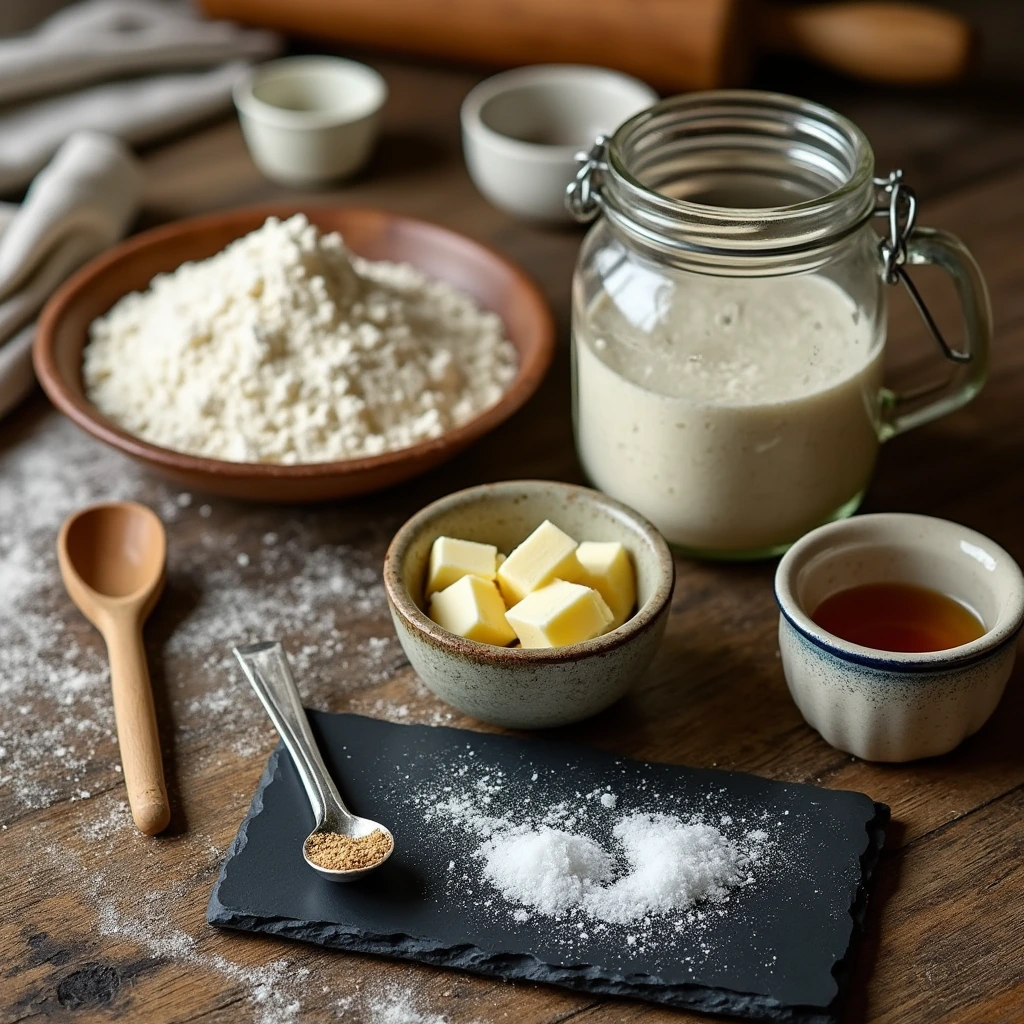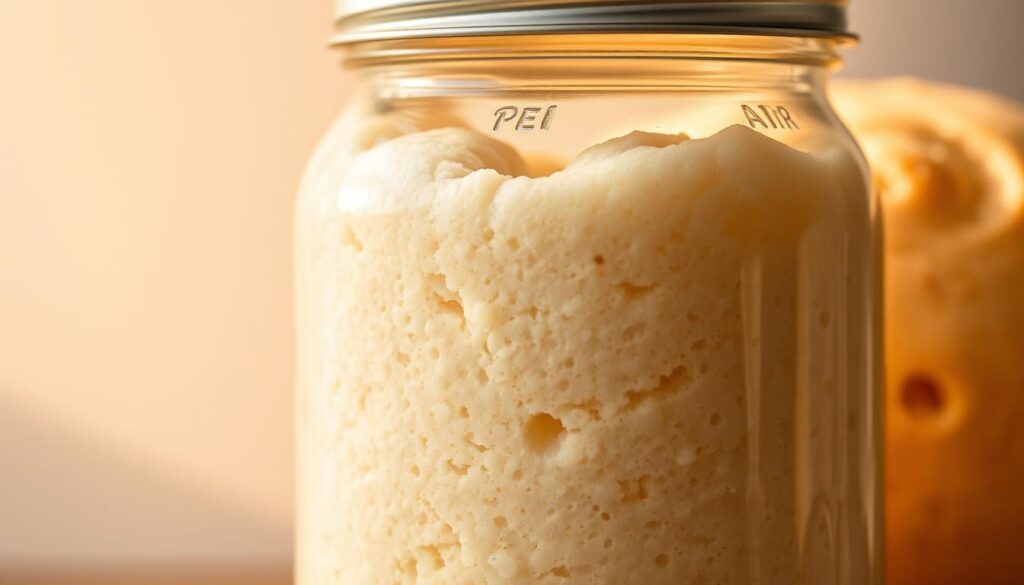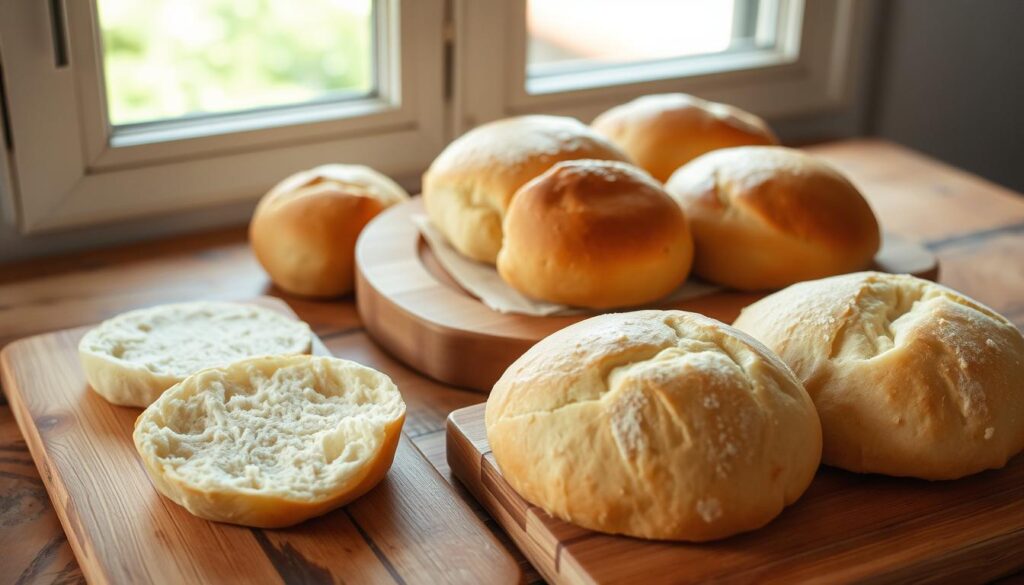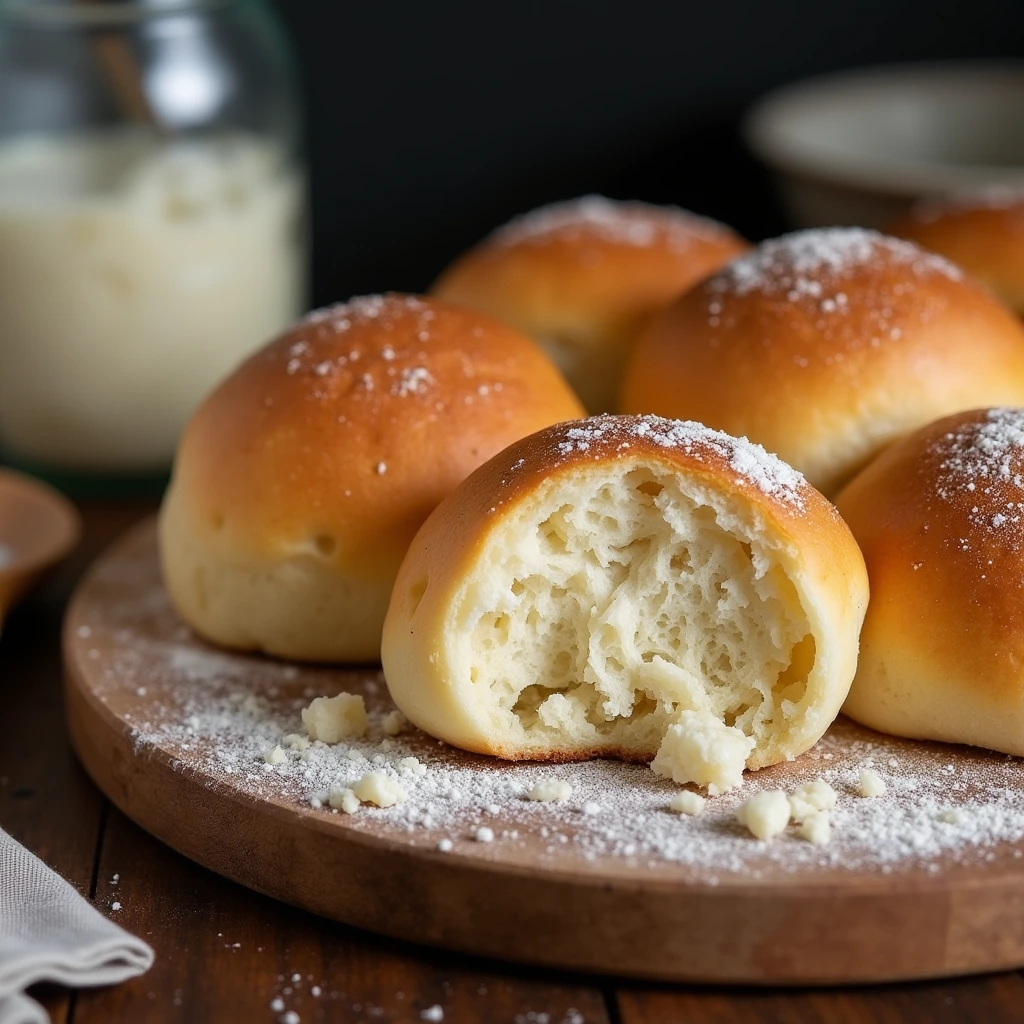Table of Contents
Ever dreamed of warm, pillowy sourdough dinner rolls without the long wait? This recipe cuts time without losing the tangy depth that makes sourdough dinner rolls unforgettable. These best sourdough dinner roll recipe results are soft, butter-ready bites. They show that quick doesn’t mean you have to compromise.
Traditional sourdough methods take hours, but there’s a secret. Smart fermentation timing and precise techniques let you enjoy bakery-quality rolls in half the time. Whether you’re a starter pro or new to natural leaven, this guide breaks down steps. It turns golden, airy rolls into your go-to dinner staple.
Key Takeaways
- Learn to balance speed and flavor in sourdough dinner rolls.
- Discover how natural yeast creates texture without commercial yeast.
- Master shortcuts for busy schedules without losing authenticity.
- Get tips to adapt dough for your kitchen’s climate and tools.
- Enjoy a recipe that impresses guests but stays simple enough for weeknights.
Understanding Sourdough Dinner Rolls: What Makes Them Special
Sourdough bread rolls are special because of how they’re made. They don’t use commercial yeast like store-bought rolls do. Instead, they use natural fermentation.
The Science Behind Sourdough Fermentation
Sourdough bread rolls are made in nature’s own chemistry lab. Wild yeast and bacteria in the starter mix with flour and water. They create gases that make the dough rise.
This process also breaks down gluten. This makes the rolls airy and chewy. Lactic and acetic acids preserve the dough and add flavor.
Taste Profile: Why Sourdough Rolls Stand Out
Sourdough bread rolls have a unique taste. It’s tangy and sweet at the same time. This comes from acids made during fermentation.
Unlike yeasted rolls, they don’t taste just yeasty. You’ll find notes of nuts, fruits, or butter. This depends on how long and at what temperature they’re fermented.
Health Benefits of Naturally Leavened Bread
Choosing sourdough bread rolls is good for you. Science shows:
- Slower digestion: Lower glycemic index than white bread
- Easier digestion: Enzymes break down gluten and phytates
- Nutrient boost: Increased mineral absorption from flour
| Comparison | Sourdough Rolls | Commercial Yeast Rolls |
|---|---|---|
| Fermentation Time | 6-12 hours | 1-2 hours |
| Flavor Complexity | Rich, layered | Simple, mild |
| Digestibility | Easier to digest | Higher gluten content |
These sourdough bread rolls are more than a trend. They’re a return to traditional methods. They offer texture, taste, and health benefits. Every bite is a story of patience and natural processes.
Essential Ingredients for Perfect Sourdough Dinner Rolls
Making homemade sourdough rolls begins with the right ingredients. High-protein bread flour gives structure. All-purpose flour adds tenderness. Whole wheat brings a nutty flavor but absorbs more liquid.
Always use filtered water to avoid chlorine, which slows fermentation. Warm water, between 85–90°F, is best for activating your starter.
- Flour: King Arthur or Bob’s Red Mill brands ensure consistent results. Measure by weight for accuracy—bread flour at 12–13% protein works best.
- Starter: Active, bubbly starter gives rise. Use 100g of fed starter per standard batch.
- Salt: Sea salt enhances flavor and controls yeast activity. Use 2% of flour weight.
- Optional add-ins: Unsalted butter (for richness), honey (for browning), or seeds (for texture) can be folded in during mixing.

Invest in a kitchen scale for precise measurements. For gluten-free diets, try Bob’s Red Mill 1-to-1 gluten-free flour blend. Always check expiration dates on flour—stale grains yield flat rolls. These basics ensure your homemade sourdough rolls have the right balance of structure, flavor, and tenderness every time.
Preparing Your Sourdough Starter for Dinner Rolls
Your sourdough starter is key to making great sourdough dinner rolls. It makes the dough rise and gives it a tangy flavor. Here’s how to get it ready.
How to Tell When Your Starter is Ready
Look for these signs before baking:
- Bubbles: A starter with tiny bubbles inside is ready.
- Float Test: If a small piece floats in water, it’s active.
- Smell: It should smell fresh and slightly sour, not off.

Feeding Schedule Before Baking Day
Follow this timeline to prepare your starter:
- 72 hours pre-bake: Feed 1:1:1 (starter:flour:water).
- 24 hours pre-bake: Double the feeding to 1:2:2.
- 12 hours pre-bake: Feed 1:3:3 for the best activity.
Feeding it more often makes the flavor milder. Longer rests make it tangier.
Using Discard vs. Active Starter
Choose based on what you have and what you want:
- Active starter: Use it right after feeding for faster rise and lighter rolls.
- Discard starter: Good if you’ve fed it regularly. Add extra proofing time for better results.
Pro tip: When using discard, increase dough hydration by 5-10% for better structure in your rolls.
Step-by-Step Guide to Making Homemade Sourdough Rolls
Starting with sourdough dinner rolls from scratch is all about following precise steps. First, mix your active starter with warm water and flour in a big bowl. Use a wooden spoon or a stand mixer to mix until it’s shaggy. Then, knead the dough by hand until it stretches thin without tearing.
Bulk fermentation comes next. Put the dough in a greased bowl, cover it, and let it rise at 70–75°F for 4–6 hours. It should double in size and have lots of bubbles on the surface. Split the dough into equal parts, shape into rounds, and place them in a greased baking dish.
Let the shaped rolls proof in a humid place for 1–2 hours. Heat your oven to 425°F with a Dutch oven inside. Score the tops with a knife before baking. Bake covered for 20 minutes, then without the lid for 15–20 minutes until they’re golden. Let them cool on a rack to keep them moist.
- Mix: Combine starter, flour, and water until shaggy, then knead until smooth.
- Rise: Let bulk ferment until bubbly and doubled in size.
- Shape: Divide dough into equal portions and form tight rounds for even baking.
- Bake: Use a Dutch oven for steam, ensuring a crispy crust and soft interior.
Timing can vary based on room temperature and starter strength. But, look for dough bubbles and oven spring to know you’re on the right track. Being patient through each step is key to getting those tangy, open-textured sourdough dinner rolls.
Fluffy Sourdough Dinner Rolls Without Commercial Yeast
Starting with a strong starter is key to making sourdough dinner rolls without yeast. A mature starter has natural enzymes and wild yeast. This helps the dough rise on its own. Aim for a hydration level of 65-70% for the right balance of softness and structure.
- Feed your starter 12 hours before mixing for peak activity.
- Use 4-6 stretch-and-fold sessions during bulk rise to trap gas bubbles.
- Preheat a Dutch oven to 475°F for instant steam retention.
Watch the fermentation time closely. Warmer kitchens need 6-8 hours, while cooler ones might take 10-12 hours. Before baking, score the rolls deeply. This helps them expand properly. Bake at 450°F for 15 minutes, then reduce the heat to 425°F for 10-15 more minutes.
Being patient is important. Slower fermentation makes the rolls tangier and chewier. If they don’t rise, check the starter’s health or extend the proofing time. Recipes without yeast require careful attention to hydration, temperature, and timing. This effort leads to rolls with airy interiors and a crisp crust, full of authentic sourdough flavor and texture.
Troubleshooting Common Issues With Sourdough Bread Rolls
Having trouble with your sourdough dinner rolls? We’ve got you covered. Let’s tackle the most common problems and find solutions. Every baking challenge has a fix—let’s get you back on track.

Why Aren’t My Rolls Rising Properly?
If your dough isn’t growing, check these things:
- Starter activity: Feed your starter and wait for it to double in 4–6 hours. If it’s slow, it needs a boost.
- Salt levels: Too much salt can slow down fermentation. Use about 2% salt compared to flour.
- Temperature: Keep your dough at 75–78°F (24–25.5°C) during rising. Use a warm oven or a proofing box.
Fixing Dense or Gummy Texture
Dense rolls often come from baking too little or not enough gluten. Here’s how to fix it:
- Adjust hydration: Rolls need 65–70% hydration. Too dry makes them tough, too wet needs more kneading.
- Check baking time: Make sure the inside reaches 190–200°F (87–93°C) with a thermometer.
- Gluten formation: Rest dough for 10 minutes after shaping. Then, gently shape again for better rise.
Adjusting for Different Climates and Seasons
| Climate | Common Issue | Solution |
|---|---|---|
| Hot/humid | Overproofing | Cool dough to 72°F (22°C) and reduce proofing time by 25%. |
| Cold/dry | Slow fermentation | Increase starter ratio (20–25% of flour) and use a proofing box. |
| High altitude | Collapsed tops | Reduce yeast (if using commercial) by 25% and bake at 400°F (200°C) for first 10 minutes, then lower to 375°F (190°C). |
Adjust your baking to fit your kitchen’s climate. Small changes can lead to consistent success with sourdough dinner rolls.
Creative Variations for Your Sourdough Dinner Rolls
Try new things with sourdough dinner rolls. Simple changes can make your dough into a blank canvas. You can add bold flavors or make them easy to freeze.
Sweet and Savory Flavor Additions
Make your sourdough dinner rolls special with mix-ins:
- Herbs & Cheese: Mix in rosemary and gruyere for a savory taste.
- Citrus & Honey: Add zest and 1–2 tablespoons honey for a hint of sweetness.
- Nuts & Seeds: Sprinkle walnuts or sunflower seeds on top for extra texture.
- Roasted Garlic: Blend in roasted garlic for a deep flavor.
Whole Grain and Specialty Flour Options
Try different flours by replacing up to 30% of all-purpose flour with:
- Whole wheat flour (add 1–2 tablespoons extra water
- Rye flour (gives a tangy taste and needs less water)
- Spelt flour (easy to mix and gentle on digestion)
Adjust the water slowly to keep the dough right.
Make-Ahead and Freezer-Friendly Tips
Make your life easier with these tips:
- Refrigerate Dough: Keep shaped rolls in the fridge for up to 24 hours for a slower rise.
- Freeze Unbaked: Freeze on a tray, then bag them up for up to 3 months. Bake for 5 minutes longer when thawed.
- Freeze Baked: Cool, wrap, and freeze for 1 month. Reheat at 300°F for 10 minutes.
Be adventurous—these tips help you make sourdough dinner rolls for any event or diet.
Serving Suggestions: Pairing Your Sourdough Rolls With Meals
Fluffy sourdough dinner rolls are perfect with dishes that match their tangy, airy texture. Learn how to make meals better by choosing the right foods and presentation.
- Rich soups like tomato bisque or lentil stew
- Roasted meats such as pulled pork or herb-seasoned chicken
- Cheese plates with sharp cheddar or brie
Elevate your table with gourmet touches:
- Spread with compound butters (herb, garlic, or lemon-infused)
- Serve on cast-iron skillets with dipping oils like olive or balsamic
- Add sea salt flakes for a final crunch
Refresh rolls before serving by wrapping in foil and reheating in a 300°F oven for 5–7 minutes. For a crispier option, toast slices lightly.
Seasonal pairings:
- Spring: Tarragon butter with asparagus salads
- Winter: Garlic butter with roasted Brussels sprouts
- Holidays: Cranberry sauce alongside turkey dinners
Pair these rolls with bold flavors to let their natural acidity balance rich ingredients. Adjust toppings and sides based on the occasion—whether casual or formal—they adapt to every meal.
Conclusion: Enjoying Your Homemade Sourdough Dinner Rolls
Making sourdough dinner rolls is a journey of patience and precision. It’s a mix of science and art. You’ll learn to shape dough into tender, flavorful rolls.
Keep your starter healthy and watch your dough closely. This will help you make rolls that are always good. You can add your own twist with herbs, seeds, or whole grains.
Keep a baking journal to track your progress. Note down starter activity, temperatures, and any changes you make. Try new things like garlic-herb or sunflower seeds. Freezing dough is also a great trick for quick meals.
Sharing your sourdough rolls with others makes the experience even better. As you get better, you’ll know when your dough is just right. This skill will grow with time, making baking a joy for years to come.
FAQ
What are sourdough dinner rolls, and how are they different from regular yeast rolls?
Sourdough dinner rolls use a natural starter instead of commercial yeast. This gives them a tangy flavor and chewy texture. The fermentation process makes them taste unique and easier to digest than regular yeast rolls.
Can I make sourdough dinner rolls without using commercial yeast?
Yes, you can! This recipe uses only your sourdough starter for light and airy rolls. Keeping your starter healthy and fed is key to getting the right rise.
How do I achieve soft and fluffy sourdough dinner rolls?
For soft rolls, knead and fold well to develop gluten. Keep the dough hydrated and ferment it properly. Good shaping and proofing also help make them fluffier.
What should I do if my sourdough rolls are dense or gummy?
Dense or gummy rolls might mean not enough gluten, too much water, or baking too short. Work on gluten development and hydration. Check your baking times and temperatures too.
How can I tell when my sourdough starter is ready for baking?
Your starter is ready when it’s bubbly, doubled in size, and smells sour. A float test can also confirm its readiness—just drop some starter in water; if it floats, it’s active.
Are there any health benefits to eating sourdough dinner rolls?
Sourdough bread is easier to digest, has less gluten, and a lower glycemic index. The fermentation process also boosts mineral absorption by reducing phytates.
How can I make ahead sourdough dinner rolls?
Prepare rolls in advance by refrigerating the dough after bulk fermentation or shaping. Wrap them well and store in the fridge for up to 24 hours. Or freeze for longer, keeping them fresh for later.
What are some creative flavor variations I can try with homemade sourdough rolls?
Try adding herbs, garlic, cheese, or whole grain flours for different tastes. Dried fruits or nuts can also add flavor, catering to various preferences.

